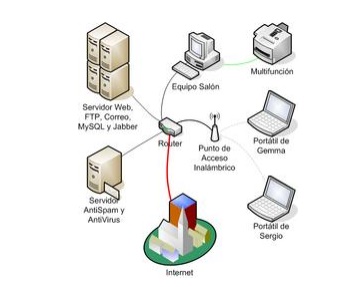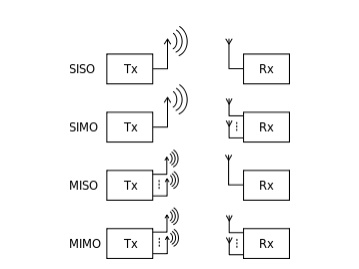Chapter: Business Science : Information Management : Security, Control and Reporting
wireless network
wireless network
A wireless
network is any type of computer network that uses wireless data connections for
connecting network nodes.
Wireless
networking is a method by which homes, telecommunications networks and
enterprise (business) installations avoid the costly process of introducing
cables into a building, or as a connection between various equipment locations.
Wireless telecommunications networks are generally implemented and administered
using radio communication. This implementation takes place at the physical
level (layer) of the OSI model network structure.
Examples
of wireless networks include cell phone networks, Wi-Fi local networks and
terrestrial microwave networks.Computers are very often connected to networks
using wireless links
Terrestrial microwave –Terrestrial
microwave communication uses Earth-based transmitters and receivers resembling
satellite dishes. Terrestrial microwaves are in the low-gigahertz range, which
limits all communications to line-of-sight. Relay stations are spaced
approximately 48 km (30 mi) apart.
Communications satellites – Satellites
communicate via microwave radio waves, which are not deflected by the Earth's
atmosphere. The satellites are stationed in space, typically in geosynchronous
orbit 35,400 km (22,000 mi) above the equator. These Earth-orbiting systems are
capable of receiving and relaying voice, data, and TV signals.
Cellular and PCS systems use several
radio communications technologies. The systems divide the region covered into
multiple geographic areas. Each area has a low-power transmitter or radio relay
antenna device to relay calls from one area to the next area.
Radio and spread spectrum technologies
– Wireless local area networks use a high-frequency radio technology similar to
digital cellular and a low-frequency radio technology. Wireless LANs use spread
spectrum technology to enable communication between multiple devices in a
limited area. IEEE 802.11 defines a common flavor of open-standards wireless
radio-wave technology known as Wifi.
1 Types of wireless networks
1. Wireless PAN
Wireless
personal area networks (WPANs) interconnect devices within a relatively small
area, that is generally within a person's reach.[3] For example, both Bluetooth
radio and invisible infrared light provides a WPAN for interconnecting a
headset to a laptop. ZigBee also supports WPAN applications. Wi-Fi PANs are
becoming commonplace (2010) as equipment designers start to integrate Wi-Fi
into a variety of consumer electronic devices. Intel "My WiFi" and
Windows 7 "virtual Wi-Fi" capabilities have made Wi-Fi PANs simpler
and easier to set up and configure.
2. Wireless LAN

Wireless
LANs are often used for connecting to local resources and to the Internet
A
wireless local area network (WLAN) links two or more devices over a short
distance using a wireless distribution method, usually providing a connection
through an access point for Internet access. The use of spread-spectrum or OFDM
technologies may allow users to move around within a local coverage area, and still
remain connected to the network.
Products
using the IEEE 802.11 WLAN standards are marketed under the Wi-Fi brand name.
Fixed wireless technology implements point-to-point links between computers or
networks at two distant locations, often using dedicated microwave or modulated
laser light beams over line of sight paths. It is often used in cities to
connect networks in two or more buildings without installing a wired link.
3. Wireless mesh network
A
wireless mesh network is a wireless network made up of radio nodes organized in
a mesh topology. Each node forwards messages on behalf of the other nodes. Mesh
networks can "self heal", automatically re-routing around a node that
has lost power.
4. Wireless MAN
Wireless
metropolitan area networks are a type of wireless network that connects several
wireless LANs.
WiMAX is a type of Wireless MAN and is
described by the IEEE 802.16 standard.
2 Wireless WAN
Wireless
wide area networks are wireless networks that typically cover large areas, such
as between neighboring towns and cities, or city and suburb. These networks can
be used to connect branch offices of business or as a public internet access
system. The wireless connections between access points are usually point to
point microwave links using parabolic dishes on the 2.4 GHz band, rather than
omnidirectional antennas used with smaller networks. A typical system contains
base station gateways, access points and wireless bridging relays. Other
configurations are mesh systems where each access point acts as a relay also.
When combined with renewable energy systems such as photo-voltaic solar panels
or wind systems they can be stand alone systems.
Cellular
network
A
cellular network or mobile network is a radio network distributed over land
areas called cells, each served by at least one fixed-location transceiver,
known as a cell site or base station. In a cellular network, each cell
characteristically uses a different set of radio frequencies from all their
immediate neighboring cells to avoid any interference.
When
joined together these cells provide radio coverage over a wide geographic area.
This enables a large number of portable transceivers (e.g., mobile phones,
pagers, etc.) to communicate with each other and with fixed transceivers and
telephones anywhere in the network, via base stations, even if some of the
transceivers are moving through more than one cell during transmission.
Although
originally intended for cell phones, with the development of smart phones,
cellular telephone networks routinely carry data in addition to telephone
conversations:
Global System for Mobile
Communications (GSM): The GSM network is divided into three major systems: the
switching system, the base station system, and the operation and support
system. The cell phone connects to the base system station which then connects
to the operation and support station; it then connects to the switching station
where the call is transferred to where it needs to go. GSM is the most common
standard and is used for a majority of cell phones.
Personal Communications Service (PCS):
PCS is a radio band that can be used by mobile phones in North America and
South Asia. Sprint happened to be the first service to set up a PCS.
D-AMPS: Digital Advanced Mobile Phone
Service, an upgraded version of AMPS, is being phased out due to advancement in
technology. The newer GSM networks are replacing the older system.
3 Global area network
A global
area network (GAN) is a network used for supporting mobile across an arbitrary
number of wireless LANs, satellite coverage areas, etc. The key challenge in
mobile communications is handing off user communications from one local
coverage area to the next. In IEEE Project 802, this involves a succession of
terrestrial wireless LANs.
4 Wireless Network Elements
The
telecommunications network at the physical layer also consists of many
interconnected wireline Network Elements (NEs). These NEs can be stand-alone
systems or products that are either supplied by a single manufacturer, or are
assembled by the service provider (user) or system integrator with parts from
several different manufacturers.
Wireless
NEs are products and devices used by a wireless carrier to provide support for
the backhaul network as well as a Mobile Switching Center (MSC).
Reliable
wireless service depends on the network elements at the physical layer to be
protected against all operational environments and applications (see GR-3171,
Generic Requirements for Network Elements Used in Wireless Networks - Physical
Layer Criteria).
What are
especially important are the NEs that are located on the cell tower to the Base
Station (BS) cabinet. The attachment hardware and the positioning of the
antenna and associated closures/cables are required to have adequate strength,
robustness, corrosion resistance, and rain/solar resistance for expected wind,
storm, ice, and other weather conditions. Requirements for individual
components, such as hardware, cables, connectors, and closures, shall take into
consideration the structure to which they are attached.
5 Difficulties
Interference
Compared
to wired systems, wireless networks are frequently subject to electromagnetic
interference. This can be caused by other networks or other types of equipment
that generate radio waves that are within, or close, to the radio bands used
for communication. Interference can degrade the signal or cause the system to
fail.
Absorption
and reflection
Some
materials cause absorption of electromagnetic waves, preventing it from
reaching the receiver, in other cases, particularly with metallic or conductive
materials reflection occurs. This can cause dead zones where no reception is
available. Aluminium foiled thermal isolation in modern homes can easily reduce
indoor mobile signals by 10 dB frequently leading to complaints about bad
reception of long distance rural cell signals.
Multipath
fading
In
multipath fading two or more different routes taken by the signal, due to
reflections, can cause the signal to cancel out at certain locations, and to be
stronger in other places (upfade).
Hidden
node problem
The
hidden node problem occurs in some types of network when a node is visible from
a wireless access point (AP), but not from other nodes communicating with that
AP. This leads to difficulties in media access control.
Shared
resource problem
The
wireless spectrum is a limited resource and shared by all nodes in the range of
its transmitters. Bandwidth allocation becomes complex with multiple
participating users. Often users are not aware that advertised numbers (e.g.,
for IEEE 802.11 equipment or LTE networks) are not their capacity, but shared
with all other users and thus the individual user rate is far lower. With
increasing demand, the capacity crunch is more and more likely to happen.
User-in-the-loop (UIL) may be an alternative solution to ever upgrading to
newer technologies for over-provisioning.
6 Capacity Channel

Understanding
of SISO, SIMO, MISO and MIMO. Using multiple antennas and transmitting in
different frequency channels can reduce fading, and can greatly increase the
system capacity.
The
maximum data rate of any single wireless link can be described by the Shannon's
theorem which is related to the bandwidth in hertz, and the noise on the
channel.
7 Network
The total
network bandwidth depends on how dispersive the medium is (more dispersive
medium generally has better total bandwidth because it minimises interference),
how many frequencies are available, how noisy those frequencies are, how many
aerials are used and whether directional antenna are in use, whether nodes
employ power control and so on.
Cellular
wireless networks generally have good capacity, due to their use of directional
aerials, and their ability to reuse radio channels in non-adjacent cells.
Additionally, cells can be made very small using low power transmitters, and
this fact is used in cities to give network capacity that scales linearly with
population density.
Related Topics